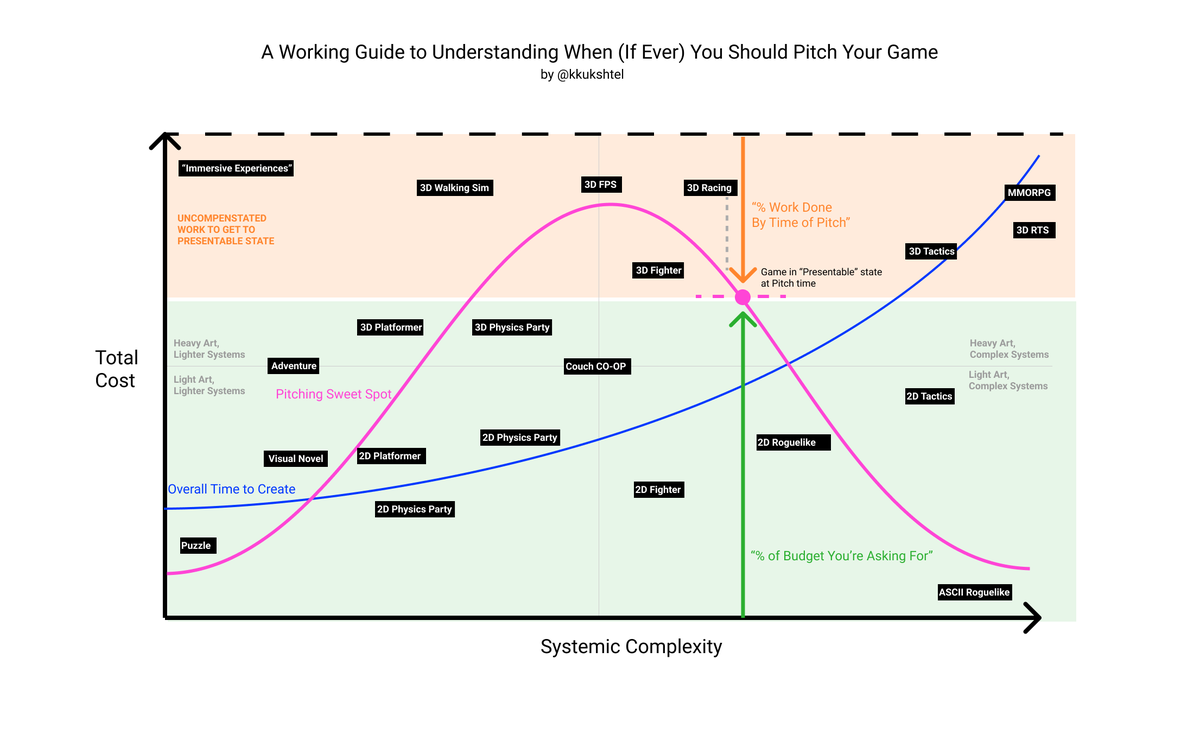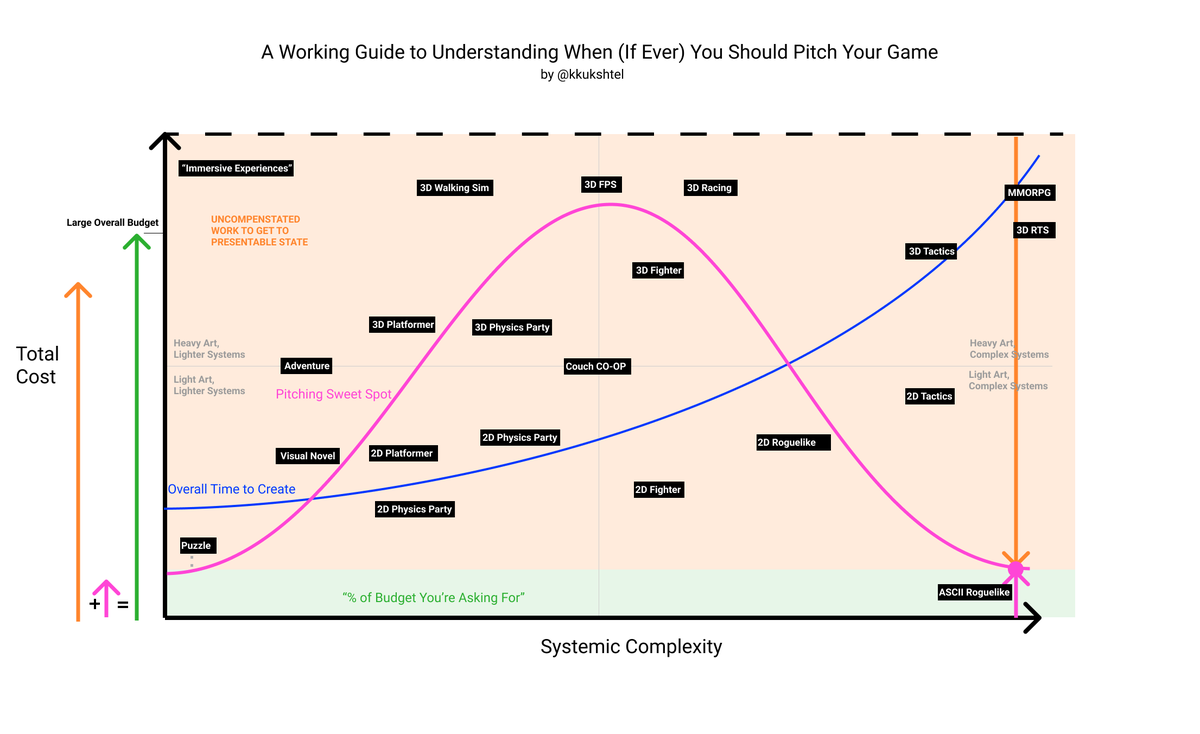OKAY - We're talking about publishers again and people are rightfully annoyed. Pubs are often VERY opaque about what they want and when, so instead of waiting for an answer I present to you The (Working) Guide on When To Pitch A Publisher (THREAD!) #gamedev 

This thing looks crazy at first but I'll walk through it. The main concepts are that there are two major axes, "Cost" and "Systemic Complexity". I'll say up front already that this thing isn't comprehensive and there are edge cases, but if you accept the general conceit let's go! 

The black label boxes are genres. They are placed where they fall on the cost/complexity spectrum. Cost _really_ correlates here to art/music/sfx, as those dev expenses don't really scale. Bigger games often mean more artists, not often (proportionally) more programmers
The purple line represents the "ideal" time to pitch a publisher during the game's development (more later). The blue line is the TOTAL development time of any genre in the same vertical access (aka a 2D platformer takes roughly as much time as a 3D platformer...generally) 

The thesis of this chart is that, despite what publishers say, there IS an ideal time to pitch your game, however the developer really bears the blunt end of that decision. There can be mitigating factors, but this assumes a general new-ish studio with no prior releases.
So let's get into it! Here's the first example - A puzzle game. The orange arrow, drawn to the purple line, determines what % of the game needs to be done at the time of pitching, and the purple arrow drawn from the bottom is the % a publisher's funding would theoretically give 

The total cost of the project is the vertical position on the chart. A puzzle game's (ideal) budget is then very small. And here's our first rub - the budget is so small that the amount of money a publisher would give at this point would be so small as to not be worth their time! 

Puzzle games are a hard sell (more later) for this reason - the amount of upfront work done by you is a lot, and a publisher wouldn't really help you before then. But also the game is so close to done and so cheap that it doesn't make sense for them to get involved.
This to say - it's really hard to pitch any sort of puzzle game! But what about other options? Let's move to the center of the chart.
At the center we can see things are much more interesting. We're looking at a 3D FPS now. A 3D FPS really benefits from the fact that it can be pretty easy to get started roughing one out that can convey your "core mechanic" - aka, "in my game the guns shoot goo" 

You don't even necessarily need compelling levels at this point. A pub would potentially back your game just because they like this core idea enough and that the "goo firing" has good shootfeel. This means you can bring in someone pretty early in the dev process to back you. 

Other games in this zone that I dubbed the "Looks Good on Twitter / Game Jam Zone" share the same characteristics - easy to quickly convey the overall tone/feel of the game without needing to implement a ton of work towards completing the whole game.
They are also at really interesting intersection of complexity. They are easy enough to whip together for small projects, but potentially can punch above their weight class for gameplay. These games also often show well at cons, even if the game only has a single level or arena.
(More on this zone later) Let's go to the far right of the chart.
Here we have a problem similar to the puzzle game problem, but also different. You can see that we're in the same situation where we are doing all the work to put the game in a demoable state for a publisher, but also that the _magnitude of cost_ for that work is MUCH greater! 

Doing 80% of the work on a puzzle game that costs 1000 to make only means you're out 800 dollars. Doing that same work on a 1m game means you're looking at some serious debt or need for other sources of income. 

The issue here is that the systemic complexity of the games on the far right is large enough that these games don't really feel like they "work" until all their mechanics are in, at which point a lot of the game is done. 

I ran into this problem a lot pitching @cantatagame around - people want to basically see a functioning tactics game before backing it. Imagine if I pitched you Monopoly but there weren't any pieces to move around on the board yet - it wouldn't make sense 

It's for this reason (and the Puzzle Issue) that I dubbed the far left and right sides of this chart the "Zones of Dismay"
Nothing but saddness is here
Nothing but saddness is here

The games in these zones are really hard sells because pitching them any earlier is "too early", but by the time you're pitching them later you're almost done and almost don't even need the help anymore. 

In between the two zones is the zone that occupies the "pop marketing discourse", which I dubbed the Zone of "Actually Viable Vertical Slice" - game in here can effectively be pitched with "minimal" work 

Games in here are highly giffable and generally conventionally "marketable". It also represents a symbiotic relationship with devs & pubs where devs feel like they can effectively pitch a small slice and ask for a reasonable sum from a publisher. 

Speaking of publishers - the edges of the graph aren't lost causes, you just have to find your publisher. Here's a rough approximation of publisher quadrants, mapped to the chart 

Let's go through them. In the bottom left I noted "Predatory Mobile Publishers" - it's a bit tongue in cheek, but IMO you shouldn't take any deal here. Your game, if you're pitching here, is mostly done, and you shouldn't give a publisher any portion of your revenue. 

In the bottom right we have Niche "Finishing" pubs - these people would pick up your game just to finish it because you're doing something unique. Wargame and text adventure pubs reside here. They don't make enough to fund dev but want to see your game in the market if possible.
In the middle are what most people would consider "indie publishers" - these are pubs that do some dev funding for projects and may have access to larger sums for bigger projects. The closer you are to the middle, the better, but outliers on the far left and right can still get $ 

I also just really want to hammer home a point here about the economics of game creation - this zone is really the meat and potatoes of "game production". Things accessible enough to mass audiences and generally good devs, so we see a lot of the titles in roughly the middle
These games are also maybe financially viable, as games can really "hit" here and have big returns. This is sort of the "indie film" of games area.
And last at the top we have AAA publishing. These are titles and genres that are prohibitively expensive enough that it's hard to make something in this area without a lot of time and money. How you're paying those is up to you, but pitching one of these to a pub will be hard.
And with that I'll close down this crazy thread. I have a lot of other thoughts about The Chart and am sure I contradict myself in some places, but overall I think it does do an okay job at sketching in a better answer then "when you feel it's ready" for when you should pitch 

Thanks for reading! If you have questions feel free to DM me or reply or whatever!
Oh also I should say if it wasn't clear from this thread - the economics of this are FUCKED! It forces development to consolidate around the middle genres, and deviating outside of that means taking a bigger financial risks just to make something that you can effectively demo
• • •
Missing some Tweet in this thread? You can try to
force a refresh




